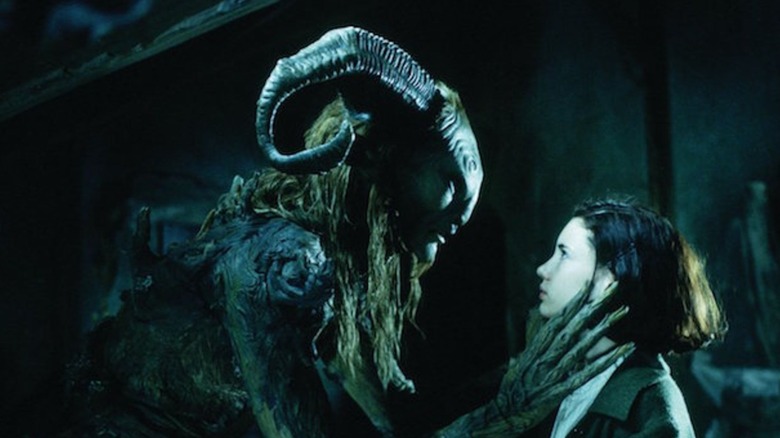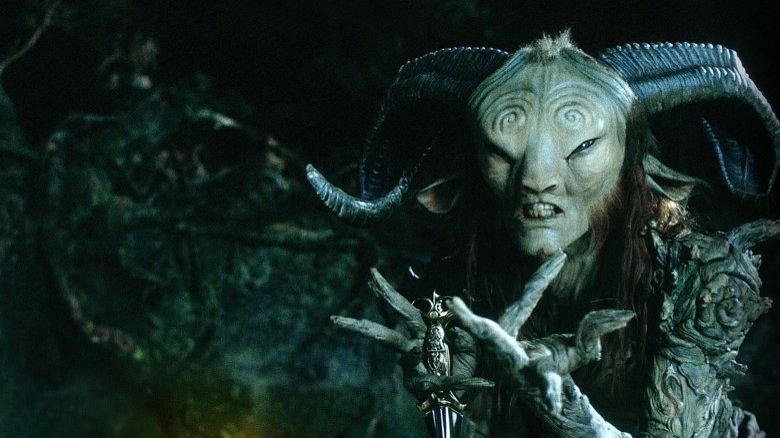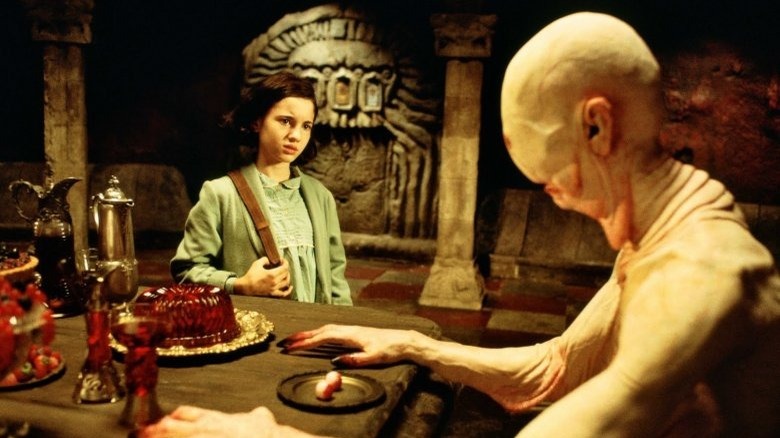15 Years On, Pan's Labyrinth Is Still Guillermo Del Toro's Masterpiece
Four years after the release of his Oscar-winning success, "The Shape of Water," Guillermo del Toro is back in the spotlight with a brand-new film. "Nightmare Alley," which features an all-star cast including Bradley Cooper, Cate Blanchett, and Willem Dafoe, sees del Toro take a turn into the world of noir. Based on the novel of the same name, it tells the story of a huckster circus employee who embarks on a new get-rich-quick scheme that involves remaking himself as an evangelical preacher with the ability to talk to the dead.
As the marketing was eager to play up, "Nightmare Alley" is all very much in del Toro's wheelhouse, from the spooky setting to the mingling with the potentially paranormal. Over the course of his 25-plus year career, del Toro has defined an instantly recognizable style that singles out his films in a crowded market that includes several eagerly inspired students of his worlds and more than a few attempted knock-offs. When you think of the del Toro canon, you see a blend of gothic, cartoonish, and fantastical. You imagine worlds populated by the most astounding creatures who are imbued with such empathy that they're often more beloved and sympathetic than the human characters. There's a blend of the beautiful and grotesque within del Toro's work that reveals his myriad influences, from the Brothers Grimm to Universal monster movies to anime. Whether the story is centered on giant robots, vengeful ghosts, or a woman making love to a sexy fish-man, you know a del Toro film when you see it. Yet there may be no other film so deliciously del Toro-esque as his 2006 masterpiece, "Pan's Labyrinth."
While del Toro was hardly an unknown entity when "Pan's Labyrinth" premiered at the Cannes Film Festival to rapturous applause and a 22-minute standing ovation — he had directed "Blade II" and won over critics with his Spanish-language horrors "Cronos" and "The Devil's Backbone" — it was certainly the film that catapulted him to a new level of industry and wider cultural awareness. The film was a major commercial hit for a foreign language release and received three Academy Awards from six nominations (sadly, del Toro went home empty-handed on that night.) By any standards, "Pan's Labyrinth" was a very big deal, and there's a reason for that. Del Toro may have won his Oscars for other films and he may have made more money with later efforts but it's "Pan's Labyrinth" that remains his greatest work, the film by which the rest of his career and stylistic evolution shall be measured.
Fairy Tales and Reality Make Ideal Bedfellows
Set in Francoist Spain during the Second World War, the young Ofelia and her pregnant mother move to the countryside to live with her new stepfather, the ferocious commander Captain Vidal. As her mother grows sicklier and Vidal zealously hunts down republican rebels, Ofelia finds herself descending into a fairy-tale world that promises freedom from her hopeless new life. Yet the offer made to her by the mysterious and impish faun requires her to fulfill some tasks that expose the true horrors that await her regardless of the route she takes.
One of del Toro's greatest traits as a storyteller is in his canny understanding that the true allure of genre fiction, with its seeming frivolities and rejection of the mundane, is in how it can be used to expose the harshest parts of our real world. Upon first watch, "Pan's Labyrinth" seems like an impossibility: a story as invested in the magic of fauns and magic as it is in revealing the sadistic horrors of fascism. Everything is shot with the same aching attention to detail, whether it's the fairies that visit Ofelia or the murder of a rebel via a glass bottle to the face. Fairy tales have always been narrative vehicles for allegory, such as Little Red Riding Hood acting as a cautionary tale about strange men and adolescent girls. For Ofelia, the baroque world of fauns and talking animals is hypnotic, of course, but it's hardly an escape from Franco-era brutality. Death is as omnipresent in the labyrinth as it is in her own home, where her stepfather commits murder with such ease that it's clear he does such things all the time. What seems incompatible at first — fairy tales versus reality — makes for ideal bedfellows. After all, the fairy stories of our youth were hardly devoid of dread.
In perhaps the most terrifying moment in "Pan's Labyrinth," Ofelia is tasked with retrieving a dagger from the lair of the Pale Man, a disgusting creature with flaps of skin over emaciated limbs who eats children (del Toro's monsters are uniquely created, unlike anything else even in the mythology that inspired them, and the Pale Man is no exception.) When Ofelia eats some of the grapes laying on his obscenely crowded table — a parallel to the fae mythology that instructs humans never to consume their food or risk eternal imprisonment — the Pale Man begins to slowly stalk her. He doesn't give chase, yet his slow movement towards this evidently terrified young girl is queasy in its horror. She may escape this time around, but she'll never be able to truly outrun the cruelties of either world.
Warmth Through Cynicism
Del Toro is an unabashedly earnest filmmaker. He may plunder the darkest echelons of humanity for insight, but he never sacrifices heart in favor of bleakness. Much like the fairy tales that have provided inspiration throughout his long career, he understands the importance of a streak of warmth through the cynicism (this is partly what makes "Nightmare Alley" so intriguing as a del Toro project — it's a story of smothering sleaze that laughs in the face of optimism.) The badness of Ofelia's circumstances are certainly hopeless but she has reason to go on, both through her fantasy world and with the compassion of Mercedes, the housekeeper and underground rebel, on her side. You can't truly escape from the world, but its glimmers of beauty are forceful enough to keep you going for one more day.
Nobody in modern pop culture loves monsters as much as Guillermo del Toro. For him, the most grotesque creatures are often the most beautiful, and they reveal more about the human condition than even our own reflections ever could. It's a running theme throughout all of del Toro's work but "Pan's Labyrinth" conveys that idea the most effectively. It's an idea that has never lost its relevance or creative potency and it won't for as long as del Toro keeps doing what he does. It's he who has shown audiences why fairy tales at their brightest and darkest still matter.


